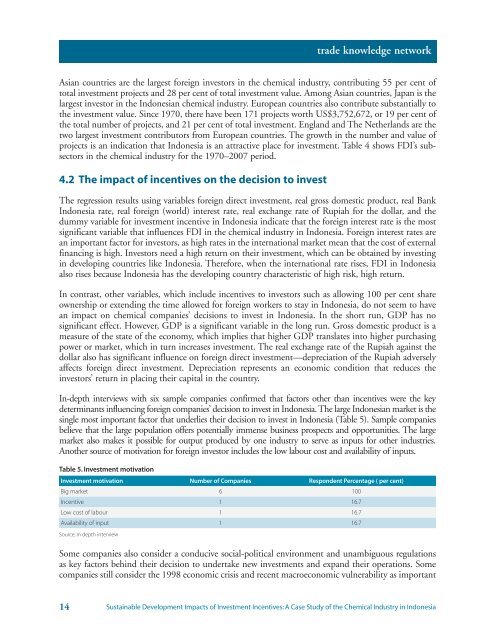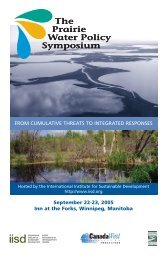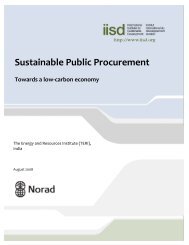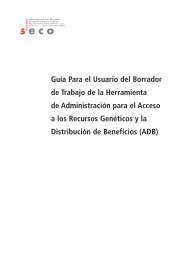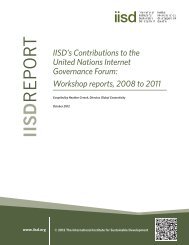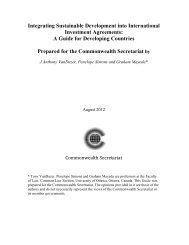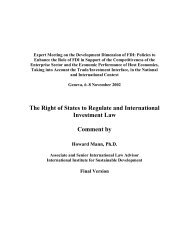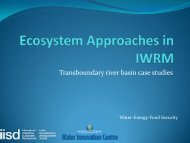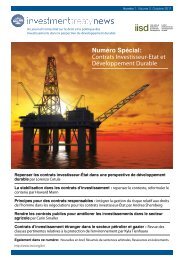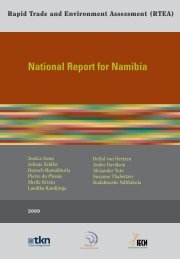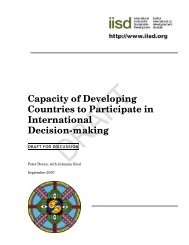Sustainable Development Impacts of Investment Incentives: A Case ...
Sustainable Development Impacts of Investment Incentives: A Case ...
Sustainable Development Impacts of Investment Incentives: A Case ...
You also want an ePaper? Increase the reach of your titles
YUMPU automatically turns print PDFs into web optimized ePapers that Google loves.
trade knowledge network<br />
Asian countries are the largest foreign investors in the chemical industry, contributing 55 per cent <strong>of</strong><br />
total investment projects and 28 per cent <strong>of</strong> total investment value. Among Asian countries, Japan is the<br />
largest investor in the Indonesian chemical industry. European countries also contribute substantially to<br />
the investment value. Since 1970, there have been 171 projects worth US$3,752,672, or 19 per cent <strong>of</strong><br />
the total number <strong>of</strong> projects, and 21 per cent <strong>of</strong> total investment. England and The Netherlands are the<br />
two largest investment contributors from European countries. The growth in the number and value <strong>of</strong><br />
projects is an indication that Indonesia is an attractive place for investment. Table 4 shows FDI’s subsectors<br />
in the chemical industry for the 1970–2007 period.<br />
4.2 The impact <strong>of</strong> incentives on the decision to invest<br />
The regression results using variables foreign direct investment, real gross domestic product, real Bank<br />
Indonesia rate, real foreign (world) interest rate, real exchange rate <strong>of</strong> Rupiah for the dollar, and the<br />
dummy variable for investment incentive in Indonesia indicate that the foreign interest rate is the most<br />
significant variable that influences FDI in the chemical industry in Indonesia. Foreign interest rates are<br />
an important factor for investors, as high rates in the international market mean that the cost <strong>of</strong> external<br />
financing is high. Investors need a high return on their investment, which can be obtained by investing<br />
in developing countries like Indonesia. Therefore, when the international rate rises, FDI in Indonesia<br />
also rises because Indonesia has the developing country characteristic <strong>of</strong> high risk, high return.<br />
In contrast, other variables, which include incentives to investors such as allowing 100 per cent share<br />
ownership or extending the time allowed for foreign workers to stay in Indonesia, do not seem to have<br />
an impact on chemical companies’ decisions to invest in Indonesia. In the short run, GDP has no<br />
significant effect. However, GDP is a significant variable in the long run. Gross domestic product is a<br />
measure <strong>of</strong> the state <strong>of</strong> the economy, which implies that higher GDP translates into higher purchasing<br />
power or market, which in turn increases investment. The real exchange rate <strong>of</strong> the Rupiah against the<br />
dollar also has significant influence on foreign direct investment—depreciation <strong>of</strong> the Rupiah adversely<br />
affects foreign direct investment. Depreciation represents an economic condition that reduces the<br />
investors’ return in placing their capital in the country.<br />
In-depth interviews with six sample companies confirmed that factors other than incentives were the key<br />
determinants influencing foreign companies’ decision to invest in Indonesia. The large Indonesian market is the<br />
single most important factor that underlies their decision to invest in Indonesia (Table 5). Sample companies<br />
believe that the large population <strong>of</strong>fers potentially immense business prospects and opportunities. The large<br />
market also makes it possible for output produced by one industry to serve as inputs for other industries.<br />
Another source <strong>of</strong> motivation for foreign investor includes the low labour cost and availability <strong>of</strong> inputs.<br />
Table 5. <strong>Investment</strong> motivation<br />
<strong>Investment</strong> motivation Number <strong>of</strong> Companies Respondent Percentage ( per cent)<br />
Big market 6 100<br />
Incentive 1 16.7<br />
Low cost <strong>of</strong> labour 1 16.7<br />
Availability <strong>of</strong> input 1 16.7<br />
Source: in depth interview<br />
Some companies also consider a conducive social-political environment and unambiguous regulations<br />
as key factors behind their decision to undertake new investments and expand their operations. Some<br />
companies still consider the 1998 economic crisis and recent macroeconomic vulnerability as important<br />
14<br />
<strong>Sustainable</strong> <strong>Development</strong> <strong>Impacts</strong> <strong>of</strong> <strong>Investment</strong> <strong>Incentives</strong>: A <strong>Case</strong> Study <strong>of</strong> the Chemical Industry in Indonesia


